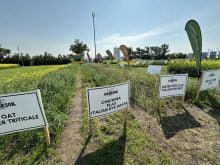I have been retired for almost 10 years, but farmers still contact me occasionally with questions about their soil test reports and for assistance with interpretation. I am a big fan of soil testing but soil sampling, soil analyses and interpretation all must be done correctly. If not, results can be very misleading and costly for a farmer.
Soil test interpretation
Soil test interpretation is often one of my greatest concerns. The question famers must ask is “What methodologies were used by the soil testing lab or agronomist to interpret their soil analyses?”
Read Also

Gentle treatments for pain in the neck
Heading toward year-end, people unknowingly tense up against the cold and busyness, causing neck pain that can often be treated with appropriate support and gentle mobility, athletic therapist Kathlyn Hossack says.
Each soil testing lab and each agronomist have their own data and philosophies they use to make to make fertilizer recommendations. Some of the different philosophies used include:
- Sufficiency using soil test calibration: Soil test methods are calibrated with numerous in-field crop trials to develop calibration tables/curves relating soil test levels with optimum fertilizer rates, for unique soil types and crops.
- Crop removal-replacement: Determine crop removal of each nutrient and replace with fertilizer needed for a target crop yield goal for nutrient requirements.
- Buildup and maintenance: Build up a soil nutrient level in excess of crop uptake and keep it maintained above a critical soil level.
- Base cation saturation ratio: This assumes the amounts of cations (potassium, calcium, magnesium) held on soil exchange sites can be manipulated with fertilizer additions to create ideal ratios. This is a flawed approach for Western Canada and is not recommended by reputable agronomists.
It is important to know the philosophies used by your soil testing lab and your agronomist. Generally, I prefer using soil test calibration for most nutrients and for most soils in each region of the Prairies.
In 1986, we concluded a soil testing lab comparison study. We took soil samples at zero- to six-, six- to 12- and 12- to 24-inch depths from two irrigated sites, one near Lethbridge and the other near Vauxhall. Samples were dried, ground and put through a soil sample splitter, for eight sets of samples. Then the samples were sent blind to six Alberta soil testing labs by a private fertilizer dealer with a request for fertilizer recommendations for irrigated wheat.
Variation in soil analyses was considerable, but the variance in fertilizer recommendations was huge. One lab provided recommendations for seven different fertilizer nutrients. The lab that performed the best at both sites was Alberta Agriculture’s Soil and Feed Testing Lab. The reason: this lab based its recommendations on years of field-calibrated research. Using the Alberta Agriculture lab recommendations were the most profitable on a per acre basis at both locations. The lab that preformed the worst was a private lab owned by a fertilizer dealer. Following this lab’s recommendations, a farmer would have lost money. The fertilizer would have cost more than the yield increase from fertilizer. This study clearly showed the considerable variance in soil lab testing and philosophy in making fertilizer recommendations. Even though we did that lab comparison study almost 40 years ago, there is still considerable variance in the soil test industry.
So, it is important that a soil testing lab or agronomist uses the fertilizer research database from your province and the region you farm, to make good fertilizer recommendations for you. If not, you are likely not going to get the best 4R fertilizer recommendations for your farm. If fertilizer recommendations are done by your agronomist, ask how they interpret the soil test report. Did they use the guidelines developed from many years of research for your province and soil/climatic area? Ask your agronomist to show you the base of information they use.
A major problem with sending soil samples to labs in other regions of Canada or the U.S. is that the recommended soil test procedures for your province may not be used. Also, odds are they don’t use your provincial fertilizer research database for making fertilizer recommendations. So, you need to ask the hard question: “Are you getting the best 4R recommendations for your farm?”
Many years ago on the Prairies, we had three main soil testing labs. The labs were run by Alberta Agriculture in Edmonton, the University of Saskatchewan in Saskatoon and Manitoba Agriculture in Winnipeg. Each laboratory had an advisory group made up of researchers, university professors, public and private agronomists and fertilizer industry agronomists, who all provided excellent advice and direction to each lab. The fertilizer recommendations used by the labs were developed in conjunction with their advisory boards and years of good solid field research.
Many older farmers have asked me why we don’t have provincial soil testing labs anymore. Good question! One significant reason was pressure from private labs that did not want the competition from the public labs. And today, none of those original labs are in business. Maybe it’s time for the three Prairie provinces to establish one good public soil and plant laboratory to serve all Prairie farmers.
Soil test calibration research
In my opinion, good, coordinated fertilizer research and soil test calibration research is lacking across the Prairies. In recent years, there has been little provincewide or Prairie-wide soil test calibration research to keep fertilizer recommendations up to date for nitrogen, phosphorus, potassium, sulphur and some micronutrients for all major crop types in the various soil regions across the Prairies. Because this has not been a focus or priority, the information database is getting older. In my opinion, this really needs to be a priority for better fertilizer recommendations for Prairie farmers in the future. I could elaborate much further on this topic — but will leave it there for this article.
Summary
Soil testing is the foundation for developing good fertilizer recommendations. But soil sampling, soil testing and interpretation all must be done with great care. Make sure you know how the fertilizer recommendations are developed for your farm.
My greatest concern, looking to the future, is the lack of good, coordinated soil test calibration/fertilizer research for all major crops across the many agro-ecological areas of the Prairies. This should receive much higher priority in the future to ensure good 4R fertilizer advice to Prairie farmers.















